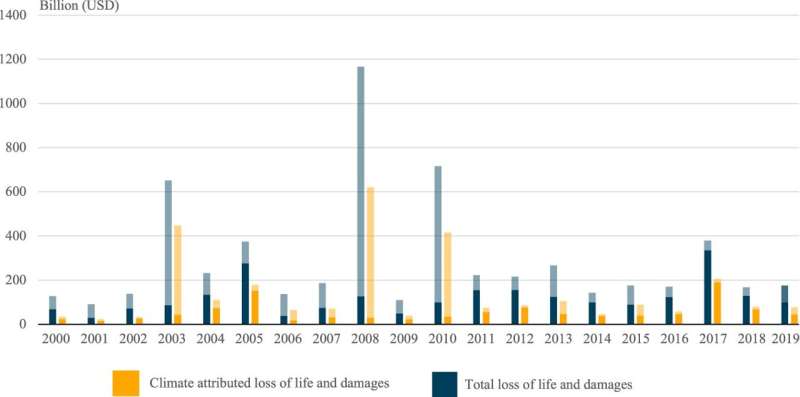October 10, 2023 report
This article has been reviewed according to Science X's editorial process and policies. Editors have highlighted the following attributes while ensuring the content's credibility:
fact-checked
peer-reviewed publication
trusted source
proofread
Calculating ongoing financial costs of climate change

A pair of financial analysts, one with the Reserve Bank of New Zealand, the other from Victoria University of Wellington, also in New Zealand, has conducted a global analysis of financial losses due to climate change. In their study reported in the journal Nature Communications, Rebecca Newman and Ilan Noy calculated estimates of damage related to climate change by comparing damage wrought by extreme weather events against economic losses over the past 20 years.
Economic forecasters are able to make predictions about the costs of climate change by comparing storms and other extreme weather events, such as droughts and heat waves, in the distant past against those that occur today, and then adding up the differences in financial losses.
Newman and Noy calculated annual average losses of $140 billion from extreme weather events due to climate change over the period 2000 to 2019, though they note that estimates from year to year varied dramatically depending on the number and type of extreme weather events that occurred.
They also suggest that their estimates are likely low due to a lack of data for many extreme events in low-income countries and note that their estimates do not include incidental costs, such as loss of crop land or a rise in sea levels.
The researchers also estimated that the number of people adversely impacted by climate change over the same time period to be approximately 1.2 billion. One notable factor that appears in their estimates is the valuation of human lives lost—$7 million per person. Their figure comes from models that have been created by economists in the U.S. and U.K. to assess average economic loss to an economy when a person dies from non-natural causes. They note that approximately two-thirds of financial losses that occur due to climate change are due to loss of human life.
The researchers suggest that their methods for calculating past losses due to climate change could be used to make estimates about future losses, which could be used to calculate how much money needs to be collected by agencies building disaster recovery funds to rebuild countries that are not able to pay for their own recovery efforts.
More information: Rebecca Newman et al, The global costs of extreme weather that are attributable to climate change, Nature Communications (2023). DOI: 10.1038/s41467-023-41888-1
Journal information: Nature Communications
© 2023 Science X Network



















